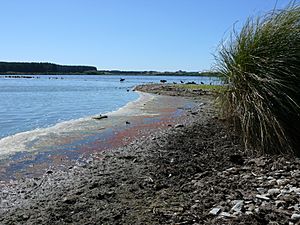Lake Horowhenua facts for kids
Quick facts for kids Lake Horowhenua |
|
|---|---|
 |
|
| Location | Southern Manawatū-Whanganui region, North Island |
| Coordinates | 40°36′36″S 175°15′17″E / 40.6100°S 175.2547°E |
| Basin countries | New Zealand |
| Surface area | 3.9 km2 (1.5 sq mi) |
Lake Horowhenua is a beautiful lake in the Horowhenua District of New Zealand. You can find it in the southern part of the Manawatū-Whanganui region, on the North Island. This lake covers an area of about 3.9 square kilometers (1.5 square miles).
The lake is also known by its Māori name, Punahau. It's a special type of lake called an aeolian lake, formed by wind. Lake Horowhenua sits on a sandy plain, about 2 kilometers (1.2 miles) west of the town of Levin. It's also only about 5 kilometers (3 miles) from the coast of the Tasman Sea. It's quite shallow, only about 2 meters (6.6 feet) deep. Many small streams feed into the lake, and its water flows out through the Hokio Stream.
Contents
A Glimpse into Lake Horowhenua's Past
Lake Horowhenua was once surrounded by thick podocarp forests. These forests were part of a rich wetland area. Wetlands are special places where land is covered by water, like swamps or marshes. They are home to many different plants and animals.
Changes to the Landscape
Over time, many of the original trees around the lake were cut down. A large part of the wetland was also drained. This means the water was removed, changing the land. Today, the lake is owned by the Māori Muaūpoko iwi (tribe). They are working hard to bring the wetland system back to its natural state. They want to make it a protected area again. The smaller Lake Papaitonga is also part of this important conservation effort.
Historical Events at the Lake
In the 1820s, the Muaūpoko people faced attacks from Te Rauparaha and the Ngati Toa tribe. Two island pā (fortified villages) on the lake were destroyed during these conflicts. The Muaūpoko people suffered many losses.
Understanding Lake Horowhenua's Water Quality
For many years, from 1952 to 1987, treated sewage from Levin was released into Lake Horowhenua. This had a big impact on the lake's health. It contributed to the lake becoming eutrophic.
What is Eutrophication?
When a lake is eutrophic, it means it has too many nutrients, like nitrogen and phosphorus. These extra nutrients can come from things like sewage or farm runoff. Too many nutrients cause a lot of algae and plants to grow very quickly. This can make the water cloudy and green. When these plants die, they use up a lot of oxygen in the water. This makes it hard for fish and other water creatures to survive.
Current Water Quality Goals
Between 2020 and 2030, there are plans to improve the water quality of Lake Horowhenua. The goal is to make sure the water meets certain national standards. This is part of the ongoing effort to restore the lake's health.



